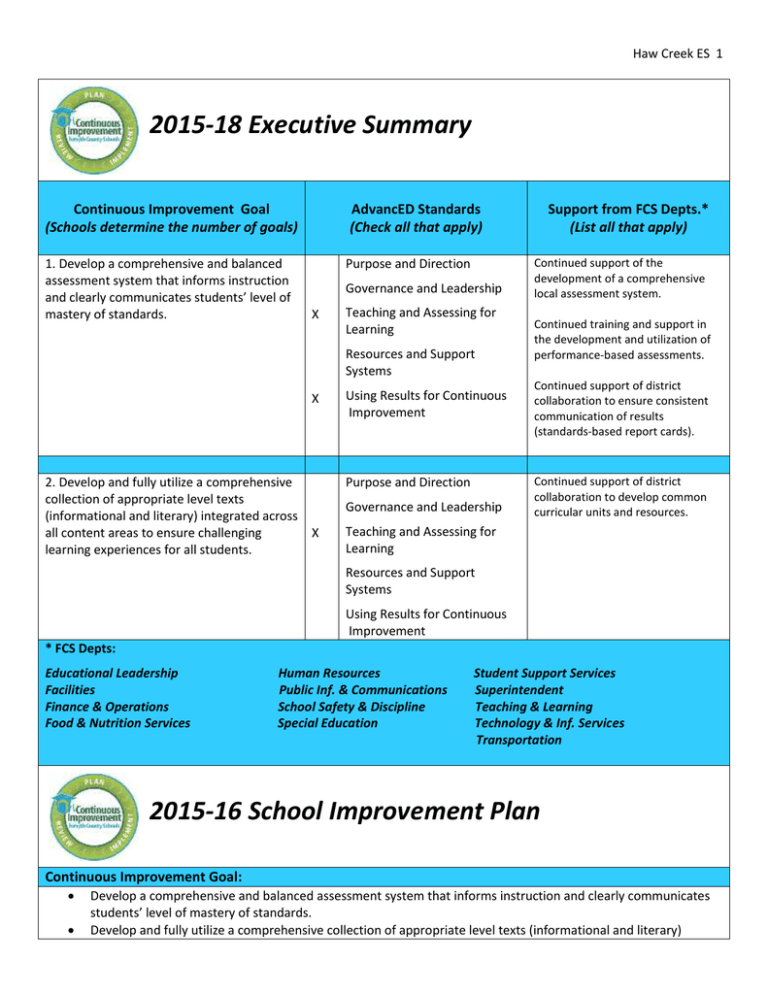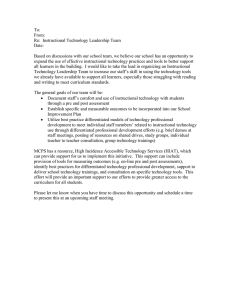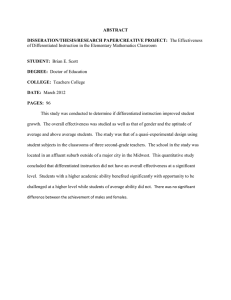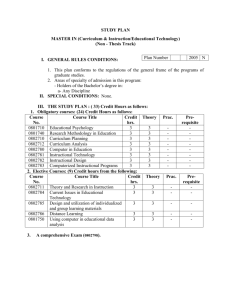2015-18 Executive Summary Continuous Improvement Goal AdvancED Standards
advertisement

Haw Creek ES 1 2015-18 Executive Summary Continuous Improvement Goal (Schools determine the number of goals) 1. Develop a comprehensive and balanced assessment system that informs instruction and clearly communicates students’ level of mastery of standards. AdvancED Standards (Check all that apply) Purpose and Direction Governance and Leadership X Teaching and Assessing for Learning Resources and Support Systems X 2. Develop and fully utilize a comprehensive collection of appropriate level texts (informational and literary) integrated across all content areas to ensure challenging X learning experiences for all students. Using Results for Continuous Improvement Purpose and Direction Governance and Leadership Support from FCS Depts.* (List all that apply) Continued support of the development of a comprehensive local assessment system. Continued training and support in the development and utilization of performance-based assessments. Continued support of district collaboration to ensure consistent communication of results (standards-based report cards). Continued support of district collaboration to develop common curricular units and resources. Teaching and Assessing for Learning Resources and Support Systems Using Results for Continuous Improvement * FCS Depts: Educational Leadership Facilities Finance & Operations Food & Nutrition Services Human Resources Public Inf. & Communications School Safety & Discipline Special Education Student Support Services Superintendent Teaching & Learning Technology & Inf. Services Transportation 2015-16 School Improvement Plan Continuous Improvement Goal: Develop a comprehensive and balanced assessment system that informs instruction and clearly communicates students’ level of mastery of standards. Develop and fully utilize a comprehensive collection of appropriate level texts (informational and literary) Haw Creek ES 2 integrated across all content areas to ensure challenging learning experiences for all students. SMART Goal: The percentage of K-3 students scoring on or above grade level in reading on the FCS SLO will increase from the 2015-2016 pre-assessment score of 63% to 85% as measured by the Fountas and Pinnell Benchmark post-assessment administered in May 2016. The percentage of 5th grade students scoring proficient in Math will increase from the 2015-2016 pre-assessment score of 7% to 47% as measured by the FCS Math Grade 5 Interim post-assessment administered in February 2016. The percentage of 4th grade students scoring proficient in Math will increase from the 2015-2016 pre-assessment score of 3% to 47% as measured by the FCS Math Grade 4 Interim post-assessment administered in February 2016. Actions, Strategies and Interventions (Includes Prof. Learning Plan) Impact on Student and Adult Behavior (“If…then...” Statements) Use data from the Fountas & Pinnell Benchmark Assessment to create flexible groups for differentiated reading instruction Timeline August 2015-May 2016 Utilize a variety of research- based instructional strategies to differentiate reading instruction (ie. STARS/CARS, Raz Kids, Ready Reading, i-ready reading diagnostic/instruction program, Accelerated Reader, SMART Phonics, Orton Gillingham, 6 Minute Fluency, Read Naturally, and Close Reading Strategies) Utilize a variety of assessment methods to track student progress in order to make informed instructional decisions and ensure the fluidity of flexible reading groups (e.g. F&P fall and winter benchmark assessments, informal running records, FASTBRIDGE, County Common Assessments) Teachers and administrators will continue to develop and implement data teams in order to monitor student progress and make informed decisions regarding SST/IST and student interventions and placement for RTI. If students are grouped according to reading level, then teachers will be able to differentiate instruction to meet student needs. Teacher will implement Number Talks, math manipulatives, Ready Math, and the i-ready math diagnostic/instruction program Teachers will implement the Math Exemplar program for students scoring proficient on FCS math interims as well as showing mastery on FCS math pre- If teachers use multiple math resources and strategies, then students will increase their level of proficiency in math. If teachers use the Math Exemplar Program, then students will increase their critical thinking and reasoning skills to solve real-world If we utilize a variety of researchbased interventions, then teachers will be able to meet specific needs of students If we use a variety of assessment strategies, then teachers will be able to plan appropriate instruction to meet student needs Resources Needed? Who is Responsible? Classroom teachers Speech pathologists and Special education teachers EIP, ESOL, and Gifted Teachers Fountas & Pinnell Reading Benchmark Assessment Kits Special Area Teachers (Science, Art, Music, PE) Level Library (Media Center Teacher/Para) I-ready, Accelerated Reading, RAZ Kids Programs Its Learning Resources Karl Mercer If teachers work collaboratively to monitor student progress, then they will have specific student data to better inform instructional planning and differentiation. August 2015-May 2016 Grade Level Teams/Admin Support Media Specialist/Para Classroom teachers Speech pathologists and Special education teachers EIP, ESOL, and Gifted Haw Creek ES 3 assessments 4th/5th teachers will use Feb. math interim data to remediate math instruction for those not scoring proficient in preparation for the Georgia Milestones Gifted teacher plans weekly with grade levels in order to provide challenging and engaging differentiated instruction in all subject areas. problems. If teachers use post-interim data to remediate math instruction, then students will increase their level of proficiency in math Professional Learning will focus on creating and implementing differentiated instruction in all subject areas. If teachers focus their professional learning on differentiation, then they will improve their instructional practices and students will achieve higher growth. If teachers use itslearning effectively, then students and parents will have a better understanding of academic expectations and the tools to achieve those expectations. If teachers collaborate, then support staff can help implement strategies to improve reading skills. If teachers use a variety of resources and genres for reading instruction, students will increase vocabulary and comprehension skills. Teachers will utilize itslearning as a learning platform for students, as a tool to differentiate instruction, and as a communication tool for parents. Continue to develop and utilize a comprehensive collection of leveled texts (informational and literacy) Collaborate as a grade level team with support staff to integrate standards across all areas Teachers Special Area Teachers (Science, Art, Music, PE) If teachers plan regularly with the gifted teacher and implement differentiated instructional strategies, then students will increase in their levels of proficiency across all content areas August 2015-May 2016 Classroom Teachers Gifted Teacher Math Resource Room HCES Administrative Team Its Learning Describe how your SMART Goal will be monitored throughout the year: We will monitor our K-3 SMART goal monthly using informal reading inventories. K-3 teachers will also administer a mid-year Fountas and Pinnell benchmark assessment to monitor student progress. Teachers will also use data from the i-ready diagnostic assessment, administered three times during the year and monthly progress monitoring data from i-ready reading and FAST Bridge to monitor growth. If students are not making progress, then grade level data teams will work collaboratively to determine research-based strategies that will be implemented during RTI to help meet student needs. We will monitor our 4th and 5th grade goals through i-ready diagnostic math assessments administered three times during the year and monthly progress monitoring data from i-ready math and FAST Bridge. We will also use data from 4th and 5th grade FSC Pre/Post Math Summative Assessments. If students are not making progress, then grade level data teams will work collaboratively to determine research-based strategies that will be implemented during RTI to help meet student needs. 2015-16 Professional Learning Plan Professional Learning Goal(s): All teachers will become proficient in using assessment data to differentiate instruction All teachers will become proficient in utilizing itslearning and Learning Station to analyze student data and Haw Creek ES 4 differentiate instruction Connection to Continuous Improvement Goal(s): Develop a comprehensive and balanced assessment system that informs instruction and clearly communicates students’ level of mastery of standards. Develop and fully utilize a comprehensive collection of appropriate level texts (informational and literary) integrated across all content areas to ensure challenging learning experiences for all students. Date July 30 Pre-Planning # Hours 8 hrs 8 hrs TKES Orientation; Self-Assessment; Pre-Conferences Grade level collaborative planning 8 hrs July 31 Pre-Planning (District) August 3 Pre-Planning August 4 Pre-Planning August 5 Pre-Planning 8 hrs 8 hrs September 2 Early Release/Prof. Dev. (District) 3.5 hrs October 23 Prof. Dev. Day (District AM/School PM) 8 hrs January 4 Prof. Dev. Day (School) 8 hrs February 16 Prof. Dev. Day (District AM/School PM) 8 hrs May 31 Post-Planning 8 hrs June 1 Post-Planning 8 hrs TOTAL HOURS: Description of Learning Activities Team Building and Collaboration Goals for the Year Data Team Review RTI/SST/IST Overview Mandated Reporter Grade level collaborative planning DCD: itslearning training, expectations for itslearning usage Grade level collaborative planning 75.5 hrs Differentiated Instructional Strategies: Grade levels will assess their proficiency in the area of differentiated instructional strategies and set a grade level goal based on area of needed growth Grade level collaborative planning ITS Learning training with Jackie O. (All Certified) SLO Training (K-3; Art, Music, PE) Crisis Team Training Grade level collaborative planning Data Teams Review Differentiated Instructional Strategies: Grade levels will create a plan for professional learning meetings centered around differentiated instructional strategies and creating plans using student assessment data DCD: Differentiated Instruction/Learning Targets Differentiated Instructional Strategies: Grade Levels will work on goals DCD: Differentiated Instruction Differentiated Instructional Strategies: Grade Levels will work on goals DCD: Differentiated Instruction Differentiated Instructional Strategies: Grade Levels will work on goals Differentiated Instructional Strategies: Grade Levels will present their work to the staff Data Analysis for School Improvement Grade Level Collaboration and Summative Data Analysis Differentiated Instructional Strategies: Grade Level Year-End Reflection




